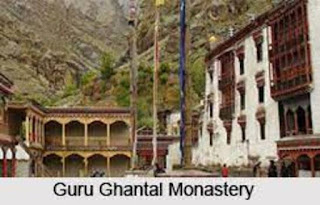Nestled amidst the serene landscapes of
Himachal Pradesh, Guru Ghantal Monastery stands as a testament to both the
spiritual legacy and architectural brilliance of ancient India. Guru Ghantal monastery also called by the name of the ‘Trilokinath Temple’ is an 800 year old
Buddhist monastery. Located near the town of Keylong in Lahaul
Valley, this monastery is revered not only for its religious significance but
also for its historical importance.
Historical Roots and Architecture:
Believed to have been founded in the 8th
century AD, Guru Ghantal Monastery is one of the oldest monastic establishments
in the region. Its name derives from "Guru Ghantal," where
"Guru" means a spiritual teacher and "Ghantal" refers to
the bell that is an integral part of the monastery. The architecture is a
unique blend of Tibetan and Indian styles, characterized by intricate wood
carvings, murals depicting Buddhist deities, and a distinctive pagoda-like structure.
Cultural Significance:
The monastery is a hub of Buddhist culture
and learning, attracting scholars and devotees seeking spiritual enlightenment.
It houses ancient scriptures, thangka paintings, and ritual artifacts that
offer insights into Buddhist practices and beliefs prevalent during its
inception. Guru Ghantal also serves as a venue for religious ceremonies and
festivals, where monks clad in traditional robes chant prayers, adding to the
mystical aura of the place.
Visitor Experience:
Visitors to Guru Ghantal Monastery are
greeted by the tranquil ambiance of the Lahaul Valley and the breathtaking
views of the surrounding snow-capped mountains. The journey to the monastery
involves a scenic drive through rugged terrain, enhancing the sense of
adventure and pilgrimage. Upon arrival, guests can explore the monastery's
interiors, participate in meditation sessions, or simply soak in the spiritual
vibes that permeate the air.
Preservation Efforts:
Efforts are ongoing to preserve and restore
Guru Ghantal Monastery, ensuring that future generations can continue to
experience its cultural and historical richness. Conservation projects focus on
maintaining the structural integrity of the monastery while safeguarding its
invaluable artifacts and paintings from the ravages of time and weather.
Conclusion:
Guru
Ghantal Monastery stands as a beacon of
Buddhist heritage in the Himalayan region, inviting travelers and pilgrims alike
to delve into its ancient wisdom and architectural splendor. Its enduring charm
and spiritual allure make it a must-visit destination for those seeking a
deeper understanding of India's cultural tapestry and the profound teachings of
Buddhism.

No comments:
Post a Comment